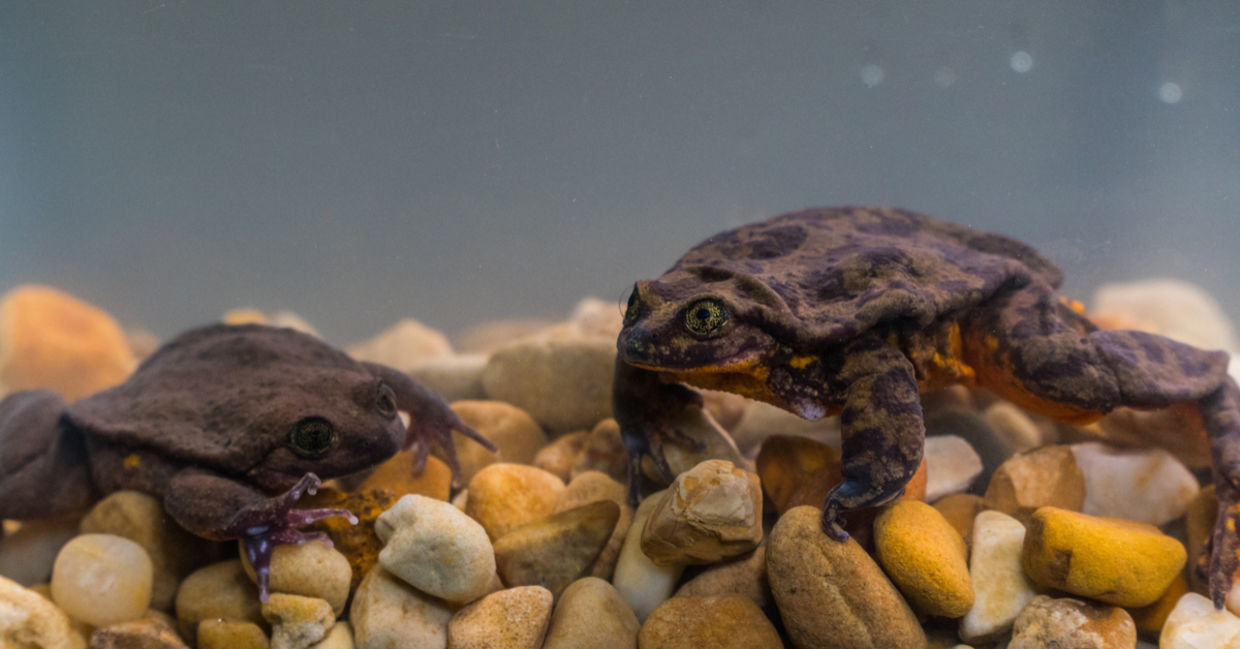
(Courtesy Global Wildlife Conservation)
Last year on Valentine's Day, a match.com profile was put up for a lonely guy named Romeo to find love. What made his profile different than any other dating profile, is the fact that Romeo is a male sehuencas water frog, thought to be the last of his species.
At first, the story of Romeo seemed like an ecological tragedy. Here was an animal destined to live as a bachelor, passing with his kind into extinction.
A little over ten years ago, Romeo was collected from the wild with the hopes of starting a breeding program because the species was almost extinct in the wild. Later searches came up empty handed, and Romeo spent the long years alone.
Water frogs were once abundant in Bolivia's Yungas – tropical cloud forests – but in recent years, the species have faced a variety of threats including loss of habitat due to destruction, climate change, pollution, deadly chytrid amphibian pathogen, and an invasive trout that eats frog eggs.
The dating profile – and a Twitter account for Romeo – were part of a Fundraising campaign to raise $15,000 to fund an expedition to see if they could find other sehuencas frogs and, most importantly, a mate for Romeo. The campaign was so successful that it raised $25,000 from people in 32 countries, according to a press release from Global Wildlife Conservation.
The funding allowed Global Wildlife and the Museo de Historia Natural Alcide d’Orbigny to mount a new expedition.
The expedition started by inspecting streams where the water frogs were previously found and other streams that had similar conditions, but they didn't find any of the elusive frogs. They decided to search one more stream before ending the expedition and then close to a waterfall, the expedition leader, and chief of herpetology at the museum, Teresa Camacho Badani saw a frog jump.
“When I pulled it out, I saw an orange belly and suddenly realized I had in my hands the long-awaited sehuencas water frog,” Camacho Badani, told The Guardian. “My first reaction was to yell ‘I found one!’ and the team came running over to help me and pull the frog to safety. It was an incredible feeling.”
The expedition collected five frogs - two females and three males. One of the females was named Juliet and became the intended for Romeo. “It is an incredible feeling to know that thanks to everyone who believes in true love and donated for Valentine’s Day last year, we have already found a mate for Romeo and can establish a conservation breeding program with more than a single pair,” said Camacho Badani.
The five frogs were brought back to the facility and put in quarantine so that they can acclimate to an environment that replicates the conditions in the wild. After a few long months, Juliet finally met Romeo in March of this year.
Their first meeting was a success and if their mating is productive, it could mean restored hope for their species.
“This first date is a significant chapter in what we hope will be a long story with a happy future for the Sehuencas water frog,” said Robin Moore, communications director at Global Wildlife Conservation and a photographer who has been following Romeo and other threatened frogs.
Romeo is giving up his worm meals for Juliet and trying his best to perfect amplexus. But after a decade of solitude, “he needs more practice,” said Camacho Badani.
“Now the real work begins—we know how to successfully care for this species in captivity, but now we will learn about its reproduction, while also getting back into the field to better understand if any more frogs may be left and if so, how many, where they are, and more about the threats they face," she added. "With this knowledge we can develop strategies to mitigate the threats to the species’ habitat, while working on a long-term plan to return Romeo’s future babies to their wild home, preventing the extinction of the sehuencas water frog.”
Other captive breeding programs have helped save the Majorcan midwife toad in Spain and the wild Kihansi spray toad in Tanzania; both of these types of frogs have been successfully reintroduced in the wild.
Other than in the original story, this Romeo and Juliet will have a happy ending when the sehuencas water frogs are successfully reintroduced into the cloud rain forests and are no longer considered endangered.
YOU MIGHT ALSO LIKE:
The Largest Protected Rainforest Is Now a World Heritage Site
How to Save the Rainforest
How to Study Endangered Species in the Most Beautiful Way







